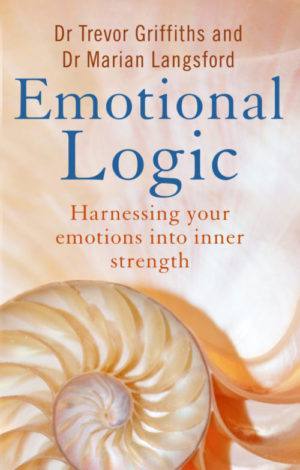We teach practical, innovative, lifelong learning skills for everyone to reduce stress, increase resilience and promote adaptability. Turn life’s challenges into personal growth.
Charity no: 1107527 | Registered no: 04756998

“Emotional Logic: Harnessing your emotions into inner strength” is the latest publication by Dr Trevor Griffiths and Dr Marian Langsford, former GPs who have developed and pioneered the concept of Emotional Logic as a means of preventing mental illness and behaviour, both in the UK and internationally. The book presents the application of Emotional Logic though a variety of real-life case studies, and also demonstrates how the materials and resources have been adapted to ensure that it can be used successfully with children, and those with neuro-diversity.
So what is Emotional Logic? The definition offered by the book is rather wordy:
“Your Emotional Logic is your inbuilt capacity for one emotion to evolve constructively into another as you prepare in different ways to adjust to the personal losses hidden within change.”
I had to read this a couple of times, and though the authors themselves admit that it’s hard to define succinctly, their website (in my opinion) does a rather better job:
“Emotional Logic is a personal development tool used…to improve emotional intelligence in difficult situations. It makes sense of unpleasant emotions. People can then harness that emotional energy to face life’s challenges, build emotional resilience and embrace change.” (https://www.emotionallogiccentre.org.uk/what-is-it/about-emotional-logic/, accessed June 2021).
Reading the book felt at times as though I was reading a university text, or training manual. The introduction, in its efforts to provide the reader with an understanding and context of Emotional Logic, weighs heavily and I found myself having to re-read sections to check that I’d taken in what I’d read. It’s a bit of a shame, as the concept of Emotional Logic is interesting, and the rest of the book is very accessible, but I found it hard to get into it through its very wordy first impression.
Introduction aside, the rest of the book is divided into two sections: Dr Marian’s Emotional Logic Casebook, and Emotional Logic in the Community. This, I’m happy to report, is much easier going. Breaking up the content into real-life case studies makes for interesting and enjoyable reading, especially the bits that Dr Marian writes herself. Her casual and chatty style makes the content very ‘readable’, and the wide range of scenarios keeps the necessarily-repetitive nature of the explanatory comments (provided by Dr Griffiths) fresh and relevant. Topics span marital conflict, troubled teenagers, young children, issues in the workplace and depressive behaviour, amongst others, and Dr Griffiths talks very clearly through how Emotional Logic was used in each instance, using the ‘Stepping Stones’ cards, to make real, tangible and positive changes for those involved.
The process is similar each time: cards are used to provide a picture of a person’s emotional state, and whilst the person is talking, a list is being made of all the hidden ‘losses’ that the person is subconsciously grieving. These represent a person’s values, what they stand to lose. Seeing a list then provides an element of choice – which one thing should we deal with first? Not so overwhelming to just pick one, so a sense of control is regained, and dealing with one issue often triggers a ‘butterfly effect’ of problem-solving. As someone who has often felt overwhelmed by anxiety, this spoke to me on many levels. It made perfect sense to me that the feeling of things seeming insurmountable would be soothed by being told to just pick one item from a list.
Other things that I related to on a personal level were the importance of a ‘safe space’, the need to be ‘heard’, and the notion that emotions, no matter how unpleasant, were nothing to be ashamed of, and actually, served a useful purpose in urging us to move that energy into something else, rather than just dwelling in our distress. It has made me consider how I relate to my children: am I an effective safe space? Do I reassure them that I have heard them? Am I guilty of dismissing their tears as trivial? Reading the book genuinely made me think about how sensitive I am to the emotions of others.
The section on Emotional Logic in the Community is an inspiring read. Describing the work that Dr Griffiths and Dr Langsford have done with Emotional Logic in various settings is eye-opening, and I found myself simultaneously impressed and wondering why the project wasn’t more widely used and known about. From gang leaders in the UK to prisons in Kenya, via anxious tweens making the transition to secondary school, and radicalisation and sex-trafficking, Emotional Logic has been able to make positive changes in people’s lives. Not just through testimony, either. Sceptics can be reassured that there are charts and scales and questionnaires to support all the claims, as well as published articles in academic journals, which add an extra level of persuasion to an already very attractive concept.
To conclude, this book should be a staple in every office, every classroom, every prison. The potential for Emotional Logic to make a real and lasting difference to, well, almost everyone, is enormous. Will it make you reflect upon your own anxieties and relationships? Yes. Will it make you want to book your workplace onto a training seminar? Probably. Is it an easy read for the general population?…Possibly. If you can persevere through the introduction, then yes, you will soon slip into the rather ‘academic’ writing style and then it’s smooth sailing, and it IS worth the perseverance. If not, then a glance at their website (www.emotionallogiccentre.org.uk) will do you no harm at all.
Written by Rachel Lane – Onceabassist.wordpress.com
“Emotional Logic: Harnessing your emotions into inner strength” by Dr Trevor Griffiths and Dr Marian Langsford is available now, published by Hammersmith Books.